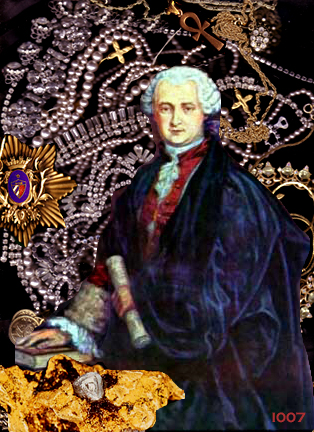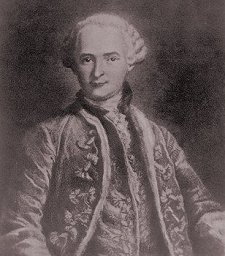St. Germain
THE LEGEND OF ST. GERMAIN
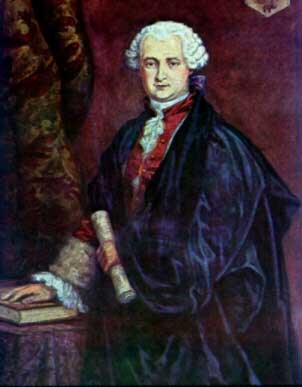
Some occultists believe that Francis Bacon continued his mastership in another life as Comte de St. Germaine. The Count was an international spy, ringleader of secret societies, enlightened visionary and proponent of U.S. freedom, urging on the Founding Fathers in their faltering moments. He carried much of Bacon's agenda and political philosophy forward in a rapidly changing world, ratifying the magical current of Roger Bacon, John Dee, Sir Francis Bacon, and himself. Wikipedia http://en.wikipedia.org/wiki/Count_of_St_Germain Francis Bacon made it appear that he died on Easter Sunday, April 9, 1626, and that he even attended his own "funeral" in disguise. He then supposedly traveled secretly to Transylvania (now part of Romania) to the Rakoczy Mansion, where he is said to have continued preparations for his physical Ascension. Since Francis Bacon was sighted in the area at various times over the following decades, the local people concluded that he must be a member of the Rakoczy family (possibly related to to Prince Ferenc Rakoczy II of Transylvania). Finally on May 1, 1684 he is believed to have attained his physical Ascension. Not wanting to leave humanity in the "physical octave" without his direct visible assistance, he asked the Karmic Board for a special Dispensation to allow him to function in a physical tangible body among embodied mankind for a limited time period — even though he was already an Ascended Master. He was granted his request at the direct intercession of the Goddess of Liberty, and reappeared as "Le Comte de Saint Germain", the "Wonderman of Europe" in the 18th and 19th centuries, or so the story goes. It is claimed that during this period in the 18th and 19th centuries: http://www.reversespins.com/rosicrucian.html Chapter Eleven from: Throughout his life, Francis Bacon's fondest hope was the creation of a Utopia across the Atlantic, the realization of his "New Atlantis" in the form of a society of free men, governed by sages and scientists, in which his Freemasonic and Rosicrucian principles would govern the social, political and economic life of the new nation. It was for this reason as Lord Chancellor, he took such an active interest in the colonization of America, and why he sent his son to Virginia as one of the early colonists. It was in America that the Rosicrucian-Freemasonic vision manifested over a few centuries. The writings of Thomas Jefferson and Thomas Paine led to revolutionary activities of many Rosicrucian-Freemasonic followers, including George Washington and Benjamin Franklin. Bacon and St. Germaine had both hoped to create a new nation dedicated to esoteric political philosophy. In his Secret Destiny of America, Manly Hall, Bacon's most understanding modern scholar, refers to the appearance in America, prior to the signing of the Declaration of Independence in 1776, of a mysterious Rosicrucian philosopher, a strict vegetarian who ate only foods that grew above the ground, who was a friend and teacher of Franklin and Washington and who seemed to have played an important role in the founding of the new republic. Why most historians failed to mention him is a puzzle, for that he existed is a certainty. He was known as the "Professor," Comte de St. Germain. http://www.reversespins.com/signthatdocument.html
Great Secret: Count St. Germain
by Raymond Bernard
Immediately after aquiring the Cage of Desire from a collecter, the Comte de Saint Germain traveled to St. Petersburg. He played an important part in the revolution which placed Catherine the Great upon the throne of Russia. Catherine deposed her incompetent husband, Peter III, just six months into her rule. He was murdered less than two weeks later by the brother of her then current lover, Grigory Orlov.
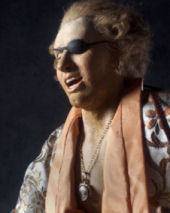
Potemkin's name was a byword for gluttony, and he rarely woke before noon. This was in sharp contrast to Catherine who rose at three in the morning to hunt and horseback ride, all the while "for 24 hours, eating nothing and drinking only cold water."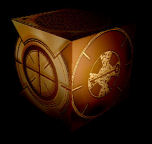
Potemkin wooed the empress with what he called "The Key to Catherine's Glory." He claimed to have won the box from the Comte de Saint Germain during a night of gambling. Potemkin and Catherine became lovers in 1774. The couple's romantic relationship lasted less than three years, but they remained close the rest of their lives.
He did not allow Catherine to touch the bronze inlaid box during these early years of their relationship. He only teased her with the sight of it, following their intimate moments together, all the while speaking dreamingly of their future destinies.
Comte de Saint Germain left Russia in the uniform of a Russian General, with full credentials to which the Imperial seal of Russia was affixed. Shortly afterward he appeared in Tunis and Leghorn while the Russian fleet was there, again in uniform, and known under the name Graf Saltikoff. Catherine allegedly placed the Masonic lodges in Russia under her personal protection in gratitude for the Comte's help in her rise to power.
http://www.pyramid-gallery.com/CageOfDesire.html

"Illuminati" - Eric Gross 2002
July 1782 http://www.pyramid-gallery.com/
The Order of the Illuminati joins forces with Freemasonry at the Congress of Wilhelmsbad.
The Comte de Virieu, an attendee at the conference, comes away visibly shaken. When questioned about the "tragic secrets" he brought back with him, he replies: "I will not confide them to you. I can only tell you that all this is very much more serious than you think." From this time on, according to his biographer, "the Comte de Virieu could only speak of Freemasonry with horror."
Also in attendence were such (il)luminaries as Cagliostro, Comte Saint Germain, Louis Claude De St. Martin, Thomas Paine, Anton Mesmer and Adam Weishaupt. In 1785 they met again at the Paris convention.
Legend of St. Germain
The Comte de St. Germain, “der Wundermann,” is a legendary figure. Little historical fact is known of this Hungarian Adept, a genius or charlatan, depending on your point of view. The Rosicrucians claim he was Sir Francis Bacon in a previous, or perhaps even extended life. New Agers count him among the Ascended Masters. He is strongly linked with the Freemasons, Rosicrucians and Knights Templar. He could allegedly astral travel or bilocate and produced an elixer of youth.
The self-styled Count has shadowy origins and his birth and death dates are unknown, as is his true identity. Saint-Germain was thought to be the love child of the widow of Charles II of Spain, or a Sephardic Jew from Portugal, although Theosophists glorify him as the son of Francis Racoczi II, the prince of Transylvania.
His birth is estimated around 1690. Some believe he still lives. But he either died around age 80-94, or pretended to die on February 27, 1784 in the German court of Prince Charles of Hesse-Kassel, a fellow alchemist. His longevity is in close accord with the 100 year lifespan goal of The Triangle Book, give or take a decade.
Calling him “the man that doesn’t die,” many continued to insist that the jewel-trading Count was very much alive. Freemason documents indicate that he represented French Masons at a meeting in 1785. Madame de Genlis claimed to have seen him in Vienna in 1821. Several travelers in the 1800's were sure they saw the miracle worker in the Far East and other parts of the world.
Theosophist Annie Besant said that she met the Count in 1896, incarnated as a "Master," or spiritual leader. In 1930 Guy W. Ballard, hiking in northern California, claimed to meet the Ascended Master on the side of Mount Shasta in his book Unveiled Mysteries (1934). He established the Saint Germain Foundation.
Fluent in all European languages, his aliases included: Christian Rosenkreutz, Prince Rakoczi, Marquis de Montferrat, Count Bellamare in Venice, Chevalier Schoening in Pisa, Cevalier Weldon in Milan, Count Soltikoff in Genoa, and Count Tazarogy in Schwalbach.
This polymath was a geat entertainer, both as conversationalist and concert level violinist who composed music. The savant was a talented painter, linguist, diplomat and skilled pharmacist or chemist, as well as alchemist. He really enchanted his listeners.
Relating events of centuries past, the Count would deliberately lead credulous listeners to believe that he had been present. "These fools of Parisians believe that I am five hundred years old," he once remarked to a friend. "I confirm them in this idea because I see that it gives them much pleasure — not that I am not infinitely older than I appear." He attributed his youthful appearance in part to his sobriety and a diet mostly of oatmeal, (Magre).
In 1743 he was reported in in London, accused as a spy for the Stewarts. He went to France around 1748, where Louis XV employed him as a spy several times. Around 1760 he was forced to leave France for England. There he taught Count Cagliostro the Egyptian Rite of Freemasonry.
By 1762 he was in St. Petersburg, meddling in the conspiracy to make Catherine the Great Queen of Russia. After returning to Paris in 1770, he prophesied the French Revolution to Marie Antoinette and her friend, Madame d'Adhémar, who wrote a story of his abilities as an Adept. Then he traveled through Germany, eventually dwelling in the state of Schleswig-Holstein.
The Count was an international spy, ringleader of secret societies, enlightened visionary and proponent of U.S. freedom, urging on the Founding Fathers, including Washington and Franklin, in their faltering moments. He woked behind the scenes for a United States of Europe. He carried much of Bacon's agenda and political philosophy forward in a rapidly changing world, ratifying the magical current of Roger Bacon, John Dee, Sir Francis Bacon, and himself.
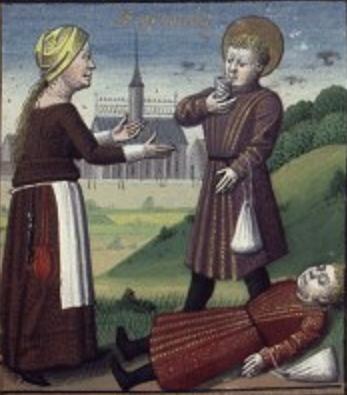
Medical Nostrums & Birth Control

THE FACE STEALER
http://www.coolfrenchcomics.com/wnu12.htm
Franz Leopold Rakoczy In 1760, Saint-Germain was in Holland, on one of his secret missions. Choiseul tried to have him arrested. As Louis XV couldn't officially support him, he was forced to flee, and he was forbidden to return to France for some time. He travelles to England, Germany, then Russia. One must note that, in 1758, a mysterious woman, presumed to be French, claiming to be 36 year-old, arrived in Utrecht, Holland. She looked well educated, kept to herself, and lived on an annuity from the French government. In 1762, her stipend having been suspended, she moved to Amsterdam, then disappeared. Rumours said that she was related to the Count of Saint-Germain, and was his mistress, or his wife. In 1784, the Bavarian Illuminati attempted to overthrow the Hapsburgs. ... the Comte de Saint Germain, was a paid agent of the French Revolution
The young prince (he was born in 1676) had spent a major portion of his life as a hostage of the Austrians, especially since they had annexed Transylvania in 1698. When war erupted between Austria and France, he was immediately jailed in the fortress of Wiener-Neustadt. That is where he met Monteleone: a man who offered him the means and energy to fight for the Transylvanian cause - and freedom. Soon afterwards, it was reported that Franz Leopold Rakoczy had escaped from Wiener-Neustadt, and that Monteleone had gone back to Sicily.
Meanwhile, at the end of 1701, the son of the Count of Monteleone and Maria Anna von Neuburg was born in Toledo. Decades later, a mysterious nobleman, whho was whispered to be the bastard son of the Queen of Spain, or alternatively Rakoczy's son, began to wander the Courts of Europe as -- the Count of Saint-Germain.
During that time, the man who was now known as Rakoczy fled first to Poland, then to Transylvania. In 1703, that principality rose against Austria. The revolt engulfed all of Hungary, which Rakoczy proclaimed an independent state in 1707. The fugitive prince haunted (figuratively speaking!) many a night of the Hapsburgs until 1710. Then, the rebellion ran out of steam, and without French support (France being itself under assault), Rakoczy was forced to flee to Prussia.
In 1714, the Spanish Succession War ended in favor of the Duke of Anjou. Rakoczy was in France at the time. He purchased in Paris a mansion on the Quai Malaquais which became known as -- theHôtel de Transylvanie . It was, in fact, the same place that author Chelsea Quinn Yarbro would later mistake for Saint-Germain's own Parisian residence . The Hotel was soon known as a place of gambling and debauchery. It is probably there that, in 1717, Rakoczy met his son, or more accurately, the son of Monteleone and Maria Anna von Neuburg:Denis, Count of Saint-Germain .
Being the illegitimate son of a queen, the young nobleman -- he was 16 at the time -- could not hope for a destiny to match his ambitions. His mother had been forced to leave Spain in 1706, and now livedin exile in Bayonne, in Southwestern France. Young Saint-Germain had grown up near her, even if the secret of his birth had remained concealed. Having recognized his father for who he was, possibly confused by the debauchery reigning in the Hotel, young Saint-Germain agreed to the exchange of bodies suggested by Franz Leopold Rakoczy. Shortly thereafter, the man who was now known as the Prince of Transylvania left Paris to retrieve his principality.
The "new" Rakoczy went first to Turkey, begging for help, Turkey being The Austrians' hereditary enemy. Unfortunately, the Turks had just negotiated a treaty of peace with Austria. So, in 1718, they jailed Rakoczy, who spent the rest of his natural life in captivity, until his death in 1735. His true mother, Maria Anna von Neuburg, died in 1740. At that time, the fame of the Count of Saint-Germain was growing throughout Europe -- alchemist, physician, polyglot, musician, painter, secret agent, detective of the occult, rosicrucian and teller of tall tales!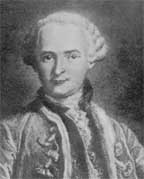 The Count of Saint-Germain
The Count of Saint-Germain
What can be told about Saint-Germain that has not been said already? Few incarnations of the Face-Stealer impressed their contemporaries more than he. Even today, crooks and lunatics claim to have met him, or have been in spiritual contact with him, or to be his reincarnation.
His public life was noticeably long -- indeed, the Face-Stealer occupied his body for more than half a century -- but he seemingly didn't grow old for decades. Some people who met him in Paris during the 1750s, found him seemingly unchanged since they had last met him in Venice in 1709-1710. It is possible that they had in fact met his biological father and double: theCount of Monteleone . A credible testimony is that of Spaniards linked to the secret community of Gomelez, who claimed to have met the Wandering Jew in 1739, near Granada...
The Face-Stealer first appeared under the name of Saint-Germain in Germany in 1743, during the Austrian Succession War. The French Marshal Belle-Isle, whom he had cured from a persistent disease, brought him back to France. Paris then became his main residence, even if he still journeyed widely through Europe, especially to London and Vienna.
It seems that he was a member of the "Secret du Roi" (The King's Secret), a secret intelligence service created by French King Louis XV, and worked on setting up alliances with England and Prussia. At the time, most of Louis XV's ministers, including Choiseul, the head of the Foreign Office, and the King's mistress, Madame de Pompadour, were in favor of seeking alliances with other catholic powers, like the Hapsburg's Austria, not protestant ones. But the Face Stealer still hated his old enemies, the Hapsburgs...
